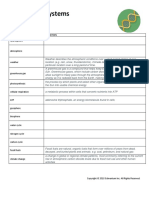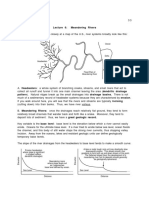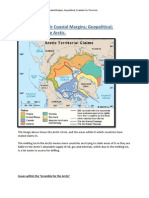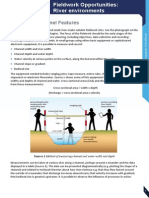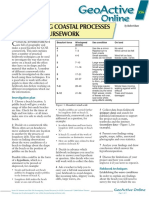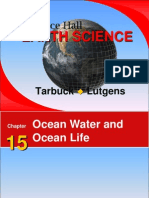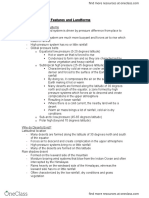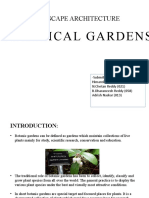IB Geography Oceans Case Studies
IB Geography Oceans Case Studies
Uploaded by
Marc WierzbitzkiCopyright:
Available Formats
IB Geography Oceans Case Studies
IB Geography Oceans Case Studies
Uploaded by
Marc WierzbitzkiOriginal Title
Copyright
Available Formats
Share this document
Did you find this document useful?
Is this content inappropriate?
Copyright:
Available Formats
IB Geography Oceans Case Studies
IB Geography Oceans Case Studies
Uploaded by
Marc WierzbitzkiCopyright:
Available Formats
Holderness coast: Location: - Located at east coast of England - 60km long
Major features:
Tourism and recreation Fishing and aquaculture Agriculture and forestry (high quality agricultural land) Energy: gas terminals (Easington and Dimlington) account for approx. 20% of Britains gas supply
Geological features:
- Mainly cliffs (20-30m high) consisting of soft, boulder clay in bands (horizontally) - Coast is exposed, approaching waves have a long fetch over the North Sea - Mainly destructive waves eroding the base of the cliff by hydraulic action, freeze thaw, abrasion, solution, slumping
- Narrow beaches that do not protect the coastline (further threatened by sealevel rise, 6mm per year) - One of Europes fastest eroding coastlines (2m per year), 4km of land have disappeared since Roman times - About 2 million tonnes of material eroded per year, some villages have completely disappeared - 3% deposited at spit (Easington) - Mappleton under threat: main road running through the village was 500m from cliff (1998), now only 50m Response / defence: - Cost-benefit analysis: costal defences cheaper than building a new road - Hard defences: concrete seawall, timber groynes (encourage the build up of beach in front of Mappleton by trapping longshore drift) - Possible solution: large underwater reef made of tyres (costly to build, but they would reduce the amount of energy that approaching waves carry) - Only most valuable areas of land are protected, much of the farmland is given back to the sea (?managed retreat?) - Construction of groyne caused erosion of about 20m per year further along the coast (spit), spit is still being eroded, but no new material can arrive - Loss of beaches for tourists use
Problems:
Barton-On-Sea: Location:
- Located at south coast of England Major features: Geological features: - First place in England to try rock groynes
- Problems with coastal erosion (1m per year, several buildings have been lost) - Longshore drift from west to east - Bournemouth (further west) built sea defences no new sediment could arrive at Barton to protect the cliffs - High energy waves approaching from SW - Cliff is undercut and slumping occurs - Cliff geology: sandstone (porous) on clay (impermeable) water collects between those two layers, causing sliding Response / defence: - 1960s: council decided to protect cliff foot by rocks and steel piles (approximate costs: 1 million GBP) (to absorb wave energy) - 1974: wooden groynes were replaced by rock groynes (they extend 1.8km along the cliff toe) (to trap sand and build a beach to protect the cliffs) - Costs since 1987 are estimated at 4.5 million GBP - Who will pay? - Visual problems it doesnt look natural - Rock groynes at Barton trap sand so coast further east is now more easily eroded
Problems:
Porlock bay: Location:
- Bristol channel, Somerset (England) Major features: - Much of the coastline under care of the National Trust - Saltmarsh is a 185 hectare biological Site of Special Scientific Interest (SSSI) - Coastline includes single ridges, salt marshes and a submerged forest - Shingle ridge which protects the marsh from the sea was weakened due to high water levels and stormy weather - Cost-benefit analysis showed that protecting the threatened land was no longer cost efficient (last rebuild of ridge took place in 1990), since then managed retreat - A new salt marsh developed provides new habitat to animals and protects the land behind from further erosion - Some land that was previously used for agricultural purposes is no longer used for farming as it is inundated by the sea at high tides
Geological features:
Response / defence:
Problems:
You might also like
- Flooding in YorkDocument24 pagesFlooding in Yorksuejacksonthree100% (26)
- Guided Notes - Cycles in Ecosystems 1Document6 pagesGuided Notes - Cycles in Ecosystems 1Yassine Koot33% (3)
- IB Geography SL Fieldwork - An Investigation of The Effects of Longshore Drift at Two Different Beaches in Aldeburgh and ThorpenessDocument58 pagesIB Geography SL Fieldwork - An Investigation of The Effects of Longshore Drift at Two Different Beaches in Aldeburgh and ThorpenessMarc WierzbitzkiNo ratings yet
- Forest Microclim GeofileDocument4 pagesForest Microclim GeofileGuy LeafNo ratings yet
- Investigating The Inverse Square Law For A Radioactive SourceDocument7 pagesInvestigating The Inverse Square Law For A Radioactive SourceMarc Wierzbitzki100% (2)
- 04 - Landscape Design StandardsDocument21 pages04 - Landscape Design StandardsMr.ClassicNo ratings yet
- The Geotraveller: Geology of Famous Geosites and Areas of Historical InterestFrom EverandThe Geotraveller: Geology of Famous Geosites and Areas of Historical InterestNo ratings yet
- Coasts Key Word Glossary (1) MDocument5 pagesCoasts Key Word Glossary (1) MRia PatelNo ratings yet
- Case Study Holderness CoastlineDocument1 pageCase Study Holderness Coastlinebiology111No ratings yet
- The Restless EarthDocument164 pagesThe Restless Earthb_osborneNo ratings yet
- 13 14 Hard Vs Soft Card Sort CompleteDocument1 page13 14 Hard Vs Soft Card Sort Completeapi-336814146No ratings yet
- GA376 Managed Coastal Retreat North Norfolk Coast - Apr 2007 Series 18 Issue 3Document4 pagesGA376 Managed Coastal Retreat North Norfolk Coast - Apr 2007 Series 18 Issue 3geoboom12No ratings yet
- 06 Meandering RiversDocument8 pages06 Meandering RiversWulan Dwikusuma AsihNo ratings yet
- Week 5 Fluvial GeomorphologyDocument70 pagesWeek 5 Fluvial GeomorphologyAndri ArrahmanNo ratings yet
- IGCSE Geography Course Notes: TectonicsDocument42 pagesIGCSE Geography Course Notes: TectonicsxerxesNo ratings yet
- India MonsoonDocument4 pagesIndia MonsoonDannySP10No ratings yet
- GCSE Rivers Revision - The Middle CourseDocument2 pagesGCSE Rivers Revision - The Middle CoursecwnoraniNo ratings yet
- What Is A Supervolcano?Document4 pagesWhat Is A Supervolcano?api-26229229No ratings yet
- Landforms Created by WindDocument35 pagesLandforms Created by WindYanjan ParajuliNo ratings yet
- Geofile Exam Techniques AsDocument4 pagesGeofile Exam Techniques AsreservoirgeogsNo ratings yet
- GEOACTIVE - Large Scale River Basin MGMT ColoradoDocument4 pagesGEOACTIVE - Large Scale River Basin MGMT ColoradoThaddeus NgNo ratings yet
- IB Geography, Oceans and Their Coastal Margins, Geopolitical, Scramble For The ArcticDocument3 pagesIB Geography, Oceans and Their Coastal Margins, Geopolitical, Scramble For The ArcticHolly OliviaNo ratings yet
- Chapter - 16 Coast and Coral ReefsDocument50 pagesChapter - 16 Coast and Coral ReefsgopeNo ratings yet
- Geography Snapshot Notes DYNPLDocument31 pagesGeography Snapshot Notes DYNPLSkye G-s100% (2)
- Geoactive 1 Stage 4 Global Geography by Susan BlissDocument408 pagesGeoactive 1 Stage 4 Global Geography by Susan BlissRoshan KonkisaNo ratings yet
- Geo IGCSEDocument3 pagesGeo IGCSEZeynep Akı100% (1)
- Physical Geography Case Study RevisionDocument17 pagesPhysical Geography Case Study Revisionapi-336814146No ratings yet
- GCSE Rivers River Landforms FormationDocument48 pagesGCSE Rivers River Landforms FormationWill TeeceNo ratings yet
- Glacial LandformsDocument29 pagesGlacial LandformsABHAN Inteli100% (1)
- Coastal FieldworkDocument4 pagesCoastal FieldworkebidNo ratings yet
- Weathering Erosion InteractiveDocument47 pagesWeathering Erosion InteractiveSunny YadavNo ratings yet
- 04.earths ResourcesDocument34 pages04.earths ResourcesChristine ValerioNo ratings yet
- Chapter 09 Coastal ProcessesDocument37 pagesChapter 09 Coastal ProcessesTheng.SethNo ratings yet
- Y9 Case Study Revision Cards and HomeworksDocument90 pagesY9 Case Study Revision Cards and Homeworkssundari21072004No ratings yet
- Glaciers Notes Part 1Document6 pagesGlaciers Notes Part 1David ZhaoNo ratings yet
- 11.mountain BuildingDocument34 pages11.mountain BuildingChristine ValerioNo ratings yet
- Geofile Rural IssuesDocument4 pagesGeofile Rural IssuesreservoirgeogsNo ratings yet
- Regenerating Places RevisionDocument19 pagesRegenerating Places Revisionapi-407286530No ratings yet
- Nning Water and GroundwaterDocument40 pagesNning Water and GroundwaterChen MoralesNo ratings yet
- Mineral and Power ResourcesDocument7 pagesMineral and Power ResourcesNilesh KhadseNo ratings yet
- Landforms PowerpointDocument21 pagesLandforms PowerpointJhaypee SorianoNo ratings yet
- 03 Agriculture GeofileDocument4 pages03 Agriculture GeofilejillysillyNo ratings yet
- Aeolian Processes and Landforms: Md. Ilias MahmudDocument44 pagesAeolian Processes and Landforms: Md. Ilias MahmudGazi Arifur RahmanNo ratings yet
- Geography NotesDocument185 pagesGeography NotesShubham SinhaNo ratings yet
- Drainage BasinsDocument4 pagesDrainage BasinsDannySP10100% (1)
- Geo DynamicsDocument2 pagesGeo DynamicsSarang BelgaonkarNo ratings yet
- 15.ocean Water and Ocean LifeDocument38 pages15.ocean Water and Ocean LifeChristine ValerioNo ratings yet
- Ice SheetsDocument19 pagesIce SheetslovleshrubyNo ratings yet
- EarthquakeDocument10 pagesEarthquakewinstonNo ratings yet
- VolcanoesDocument10 pagesVolcanoesShazira AllyNo ratings yet
- Continental Drift Seafloor SpreadingDocument30 pagesContinental Drift Seafloor SpreadingRainier Magno100% (1)
- Atmospheric MoistureDocument25 pagesAtmospheric MoistureClaudyo A Lerry Mande100% (1)
- Lecture 9 Desert Features and Landforms PDFDocument4 pagesLecture 9 Desert Features and Landforms PDFaliNo ratings yet
- Biomes 1.1Document23 pagesBiomes 1.1cristinejoygenova43No ratings yet
- Weathering and Erosion 2013Document114 pagesWeathering and Erosion 2013cmillica1176100% (1)
- The 3 Gorges DamDocument4 pagesThe 3 Gorges Damapi-361310234No ratings yet
- Plate Tectonics Web Quest StudentDocument9 pagesPlate Tectonics Web Quest Studentapi-26422289783% (6)
- 1.1 What Is A Geographer?: © Hodder & Stoughton 2018Document10 pages1.1 What Is A Geographer?: © Hodder & Stoughton 2018Baekhyunee PubbyNo ratings yet
- Most Dangerous Deserts In The World | Deserts Of The World for Kids | Children's Explore the World BooksFrom EverandMost Dangerous Deserts In The World | Deserts Of The World for Kids | Children's Explore the World BooksNo ratings yet
- Interesting Facts About Glaciers - Geology for Beginners | Children's Geology BooksFrom EverandInteresting Facts About Glaciers - Geology for Beginners | Children's Geology BooksNo ratings yet
- Case Study For Coastal Erosion Holderness Revision NotesDocument3 pagesCase Study For Coastal Erosion Holderness Revision NotesRahil BhavanNo ratings yet
- Using Snell's Law To Measure The Refractive Index of PerspexDocument5 pagesUsing Snell's Law To Measure The Refractive Index of PerspexMarc Wierzbitzki100% (4)
- Finding The Resistance of An Electrolyte (Iron Sulphate)Document4 pagesFinding The Resistance of An Electrolyte (Iron Sulphate)Marc WierzbitzkiNo ratings yet
- Melting Ice To Find The Value of The Latent Heat Capacity of Fusion of IceDocument3 pagesMelting Ice To Find The Value of The Latent Heat Capacity of Fusion of IceMarc Wierzbitzki0% (1)
- Finding The Gravitational Acceleration (G) (Atwood's Machine)Document4 pagesFinding The Gravitational Acceleration (G) (Atwood's Machine)Marc WierzbitzkiNo ratings yet
- IB TOK Essay - "'Through Different Methods of Justification, We Can Reach Conclusions in Ethics That Are As Well-Supported As Those Provided in Mathematics.' To What Extent Would You Agree?"Document6 pagesIB TOK Essay - "'Through Different Methods of Justification, We Can Reach Conclusions in Ethics That Are As Well-Supported As Those Provided in Mathematics.' To What Extent Would You Agree?"Marc WierzbitzkiNo ratings yet
- IB Business and Management Coursework SL - Will Apple Be Able To Remain The Leader in The Tablet Market Over The Next Few Years?Document12 pagesIB Business and Management Coursework SL - Will Apple Be Able To Remain The Leader in The Tablet Market Over The Next Few Years?Marc WierzbitzkiNo ratings yet
- SUDS Design and Adoption GuideDocument114 pagesSUDS Design and Adoption GuideEgia YosepNo ratings yet
- Urbanism As A Necessity Change Agents in PDFDocument11 pagesUrbanism As A Necessity Change Agents in PDFJota DeNo ratings yet
- SEDIMENTARY FACIES AND ENVIRONMENTSpptDocument98 pagesSEDIMENTARY FACIES AND ENVIRONMENTSpptfathimajihanmNo ratings yet
- FY23 H 2B Randomization List January Rev 1Document6 pagesFY23 H 2B Randomization List January Rev 1VERONICANo ratings yet
- Philosophy and Theory of Vernacular Arch PDFDocument13 pagesPhilosophy and Theory of Vernacular Arch PDFpatrick racionalistaNo ratings yet
- Dynamic Compaction in The Context of Liquefaction: Max MaxDocument2 pagesDynamic Compaction in The Context of Liquefaction: Max MaxTynash NyakatsapaNo ratings yet
- SalakamcheruvuDocument3 pagesSalakamcheruvuVijay AnandNo ratings yet
- Our Changing Earth-Worksheet-Grade 7Document2 pagesOur Changing Earth-Worksheet-Grade 7mohamedfarhaan156No ratings yet
- A Case Study of LongValleyDocument105 pagesA Case Study of LongValley周思中No ratings yet
- Botanical Gardens: Landscape ArchitectureDocument22 pagesBotanical Gardens: Landscape ArchitectureAdrish NaskarNo ratings yet
- Dissertation Paper - Gautham SajishDocument7 pagesDissertation Paper - Gautham SajishKiran AntonyNo ratings yet
- Lec 5Document24 pagesLec 5faizankhan23No ratings yet
- Canals 25072022Document44 pagesCanals 25072022Reiger RoyalNo ratings yet
- Organic and Inorganic Landscape ElementsDocument29 pagesOrganic and Inorganic Landscape ElementsAli ZainalNo ratings yet
- Aesthetic Appreciation of The Natural EnvironmentDocument14 pagesAesthetic Appreciation of The Natural EnvironmentRaissa AzarconNo ratings yet
- Constech-Group-6 20240602 203543 0000Document42 pagesConstech-Group-6 20240602 203543 0000Rachelle Ann FuentesNo ratings yet
- What Is ErosionDocument5 pagesWhat Is ErosionJoya Sugue AlforqueNo ratings yet
- Appendix 1 Aboriginal Community Participation in The Preparation of The Lake Macquarie Aboriginal Heritage StrategyDocument42 pagesAppendix 1 Aboriginal Community Participation in The Preparation of The Lake Macquarie Aboriginal Heritage StrategyDorjeNo ratings yet
- Sustaining Fukuoka City's IdentitiesDocument9 pagesSustaining Fukuoka City's IdentitiesAnonymous buw7CHuBNo ratings yet
- Lesson 3 (TLE6AG-0c-3) 1.3.3Document33 pagesLesson 3 (TLE6AG-0c-3) 1.3.3Guia Marie Diaz Brigino100% (1)
- Partido State University: Module 12: Arid and Semi-Arid EnvironmentsDocument8 pagesPartido State University: Module 12: Arid and Semi-Arid EnvironmentsRalph NavelinoNo ratings yet
- Cross Sections of Canal: 1) CHANNEL IN CUTTING: - A Channel Is Said To Be in Cutting When The GroundDocument9 pagesCross Sections of Canal: 1) CHANNEL IN CUTTING: - A Channel Is Said To Be in Cutting When The GroundSavan RabariNo ratings yet
- Masterplanning For SuDS Part 5 PDFDocument2 pagesMasterplanning For SuDS Part 5 PDFYasser Yousif Al-ahmadyNo ratings yet
- Oma ProgramDocument11 pagesOma ProgramAndru AndreeaNo ratings yet
- Purnaumbara 2023 IOP Conf. Ser. Earth Environ. Sci. 1218 012028Document21 pagesPurnaumbara 2023 IOP Conf. Ser. Earth Environ. Sci. 1218 012028198704212019031009No ratings yet
- Solucionario Braja Das Cap 2Document10 pagesSolucionario Braja Das Cap 2AsclepíadesCedroNo ratings yet
- Sitari Guideline Rev 5 LR January 2017Document52 pagesSitari Guideline Rev 5 LR January 2017Forbes KambaNo ratings yet
- Krzeminska 2023Document10 pagesKrzeminska 2023dabboodcNo ratings yet
- Soil Classification 2Document59 pagesSoil Classification 2Muhammad AwaisNo ratings yet

